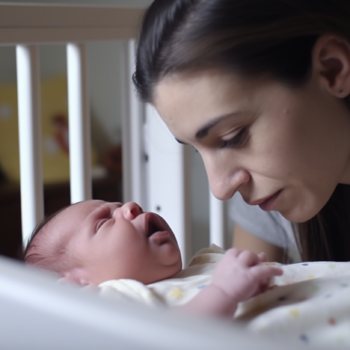If you're a sleep-deprived parent desperately seeking a solution to your child's sleep issues, you may have come across the "cry it out" sleep training method. But is it the right choice for your little one? While controversial, many parents swear by this approach. Cry it out involves letting your baby cry for predetermined intervals before providing comfort. Advocates argue that it teaches self-soothing skills and leads to longer, more restful sleep. However, critics argue that it may harm the bond between parent and child. Ultimately, the decision is yours as a parent, but it's important to consider all the factors before embarking on this sleep training journey.
Tag: cry it out method
The Impact of Sleep Training on Babies: Debunking Harmful Misconceptions
Are you considering sleep training for your baby but concerned about the potential harm it may cause? Sleep training is a hotly debated topic among parents. Some argue that it can lead to long-term negative effects on a child's mental and emotional well-being, while others swear by its effectiveness in establishing healthy sleep habits. While there are differing opinions, it's important to consider the scientific evidence. Many studies suggest that sleep training, when done correctly and with compassion, can have positive outcomes for both babies and parents. It can teach babies self-soothing skills, improve their overall sleep quality, and reduce sleep disturbances. However, it's crucial to approach sleep training with caution, ensuring that it aligns with your child's unique needs and temperament. Consulting with a pediatrician or sleep specialist can offer valuable guidance and support in making the best decision for your baby's sleep routine. Ultimately, the choice is yours to make based on what you believe is best for your little one.
Common Sleep Training Techniques: A Guide to Help Your Baby Sleep Better
Sleep training is a popular method used by parents to help their babies develop healthy sleep habits. Some common techniques include the Ferber method, the extinction method, and the chair method. The Ferber method involves gradually increasing the amount of time you wait before comforting your baby, helping them learn to self-soothe. The extinction method, also known as "cry it out," involves leaving your baby to cry until they fall asleep without any intervention. The chair method involves sitting next to your baby's crib until they fall asleep and gradually moving the chair further away over time. These techniques may vary in intensity and duration, so it's important to choose a method that aligns with your parenting style and your baby's needs. Remember, consistency is key when it comes to sleep training, and it may take some time for your baby to adjust.
Top Sleep Training Methods: A Comprehensive Guide for a Restful Night’s Sleep
If you're struggling with your little one's sleep patterns, you're not alone. Sleep training can be a game-changer for both parents and babies. There are several tried and tested methods to help your child develop healthy sleep habits. The Ferber method involves gradually increasing time between comforting visits, while the Weissbluth approach emphasizes creating a consistent bedtime routine. Another popular method is the fading technique, which gradually reduces parental presence at bedtime. The cry-it-out method, though controversial, involves allowing your baby to self-soothe without interference. No matter which sleep training method you choose, consistency and patience are key. Remember, it's important to find an approach that aligns with your parenting style and your child's unique needs. With time and a little perseverance, you can help your child develop the gift of sound sleep.
Expert Tips: How to Teach Your Baby to Nap for Better Sleep and Development
As a parent, you know that a well-rested baby is a happy baby. But how do you teach your little one to nap? The key is establishing a routine and creating a sleep-conducive environment. Start by setting a consistent nap schedule and creating a calming bedtime routine. Ensure your baby's sleep space is quiet, dark, and cool. Consider swaddling or using a sleep sack to help your baby feel secure. If your baby is having trouble settling, try using white noise or a gentle touch. Remember, naps are important for your baby's development, so don't give up if it takes a little time to establish a routine. With patience and persistence, you can help your baby learn to love napping.
Effective Tips to Simplify Sleep Training for Toddlers
Sleep training a toddler can be a daunting task, but with the right approach and patience, it can be made easier. Establishing a consistent bedtime routine, setting clear boundaries and expectations, and gradually reducing nighttime feedings can all contribute to better sleep habits for your little one. It's also important to create a sleep-conducive environment, such as a dark and quiet room with a comfortable bed. Consistency is key when it comes to sleep training, so stick to your plan and don't give up. With these strategies in place, you can help your toddler develop healthy sleep habits that will benefit their overall well-being.
Preparing Your Baby for Successful Sleep Training: Tips and Tricks
Preparing your baby for sleep training can make a big difference in the success of the process. Start by establishing a consistent bedtime routine, including soothing activities like a warm bath and a lullaby. Gradually adjust the timing of feedings to encourage longer stretches of sleep at night. Make sure your baby is well-rested during the day and not overtired when bedtime rolls around. Consider using a white noise machine or swaddling to create a calming environment. Finally, be patient and persistent – sleep training takes time and effort, but the payoff is a well-rested and happier baby (and parents too!).
Understanding Cry It Out Method for Sleep Training: A Comprehensive Guide
Cry it out sleep training, also known as the extinction method, is a controversial sleep training approach where parents allow their babies to cry until they fall asleep without any intervention. This method has been popularized in recent years, with some parents reporting success in getting their babies to sleep through the night. However, the approach has also been criticized for being too harsh and potentially damaging for the baby's mental health. Despite the debate, many parents continue to use this method, and it remains an option for those seeking a solution to their baby's sleep troubles.
When to Begin Sleep Training for Your Baby: Expert Tips and Guidelines
Are you a new parent wondering when to start sleep training your little one? The answer may vary depending on your baby's age and development, but most experts recommend starting between 4 and 6 months. At this age, babies have established a regular sleep pattern and are able to self-soothe. By implementing a consistent bedtime routine and gradually teaching your baby to fall asleep on their own, you can help them develop healthy sleep habits that will benefit them for years to come. Don't wait too long to start sleep training, as the longer you wait, the harder it may be for your baby to adjust to a new routine.
A Beginner’s Guide to Sleep Training for Infants: Benefits and Techniques Explained
Sleep training for infants is a process of teaching babies how to sleep independently through the night. It involves gradually reducing the presence and intervention of parents during bedtime routines. Sleep training may include methods such as the Ferber method, the cry it out method, or the chair method, and involves establishing a consistent sleep schedule and routine. While sleep training can be controversial, it can be a helpful solution for parents who are struggling with sleep deprivation and are looking for a way to help their baby get the rest they need. It is important to note that sleep training should only be done when the baby is developmentally ready and should always be done under the guidance of a pediatrician.


